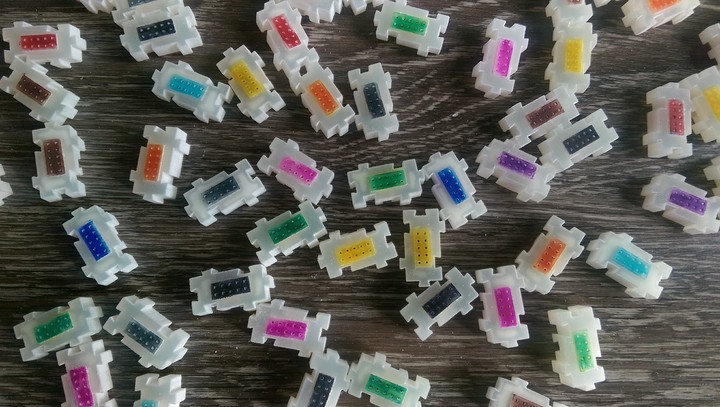BitBlox: Redesigning the Breadboard
 BitBlox!
BitBlox!
Overview
BitBlox was a project creating a modular solderless breadboard that is easier for students to learn. It was designed to be used as a research probe to understand how to promote collaboration and learning in physical computing. The modularity of the BitBlox boards enables students to create their prototyping tool as they build their circuit; while the coloring, helps minimize the overhead for learning the tool (ie. designed to minimize the cognitive load). The development of BitBlox was our first exploration of the tools for physical computing.

Motivation
In our initial work with physical computing, we were using the Arduino Microcontroller and the SparkFun Inventor’s Kit because it provides a flexible environment for students to explore the electronics, computing, and design concepts embedded within all physical computing artifacts. However, from an educational standpoint working with the Arduino environment has steep learning curve with little scaffolding. This poses issues for novices of programming and electronics. One stumbling block that seemed unnecessary was the breadboard. Not wanting to black-box the electronics, we designed and built BitBlox in order to try and reduce the cognitive load for students working in an Arduino environment.
Design
BitBlox is similar to the standard breadboard in that it is still a solderless prototoyping tool allowing the user to create connections between wires and components by placing them into holes that are electrically connected. The standard breadboard has connection schemes as shown in the image below. The top and bottom sections have the entire row connected while the middle sections are connected in columns. The back of the breadboard shows the metal pieces that actually create the connections.

BitBlox bring visibility to where the connections actually are in the tool with the coloring. Each section of holes that are the same color are electrically connected. Below are images of the various types of BitBlox that we have created. These different types were created to allow a user to also use components with fixed width pins such as LCD screens, transistors, and IC chips.

We’ve piloted them with College students at Georgia Tech and Berry College, as well as with High School students. Here are some images of circuits the high school students made during one of our classroom studies. You can read about the comparative classroom study with high schoolers below along with a lab study that worked with novices across universities.



Research
Comparative Classroom Study with High School Students
The high school classroom study with BitBlox, we analyzed two 11th grade classes at a rural public high school that had a focus on tying the students’ education to the strong agricultural connections in their community. We worked with 44 novice students in two drafting classes where students often participated in project work designing and building objects. In this study, we used two classes to understand effect different prototyping tools had on the socio-technical environment. One class used the standard breadboard prototyping tool and one used BitBlox. During the class, students learned the basics about the Arduino, and then built a circuit to play the Simon Memory game using three buttons and three LEDs. The study highlighted three important effects the tools had in the learning environment:
- The novice students learned about the utility of organizational affordances of the tools, such as the wire colors and the connections between the BitBlox modules, in order to minimize the errors they were making
- BitBlox spread out the circuit, increasing the size of the tool, which improved students’ ability to collaborate and create a shared understanding with each other and the instructors
- The identifiers such as color and symbols on the breadboards facilitated students in dialogue about their circuits, allowing them to reference parts of their circuit when troubleshooting and explaining their circuits
Laboratory Study with Novices
We wanted to understand more clearly what was happening as novices began working with the Arduino for the first time. In the study, we video recorded 31 novices working with the Breadboard and the BitBlox as they completed various tasks. Video and audio recordings captured participants’ actions and thoughts as they worked. The study provided three contributions:
- A codebook of the common breakdowns faced by novices
- Insight into the work processes of novices
- An understanding of the ways that the tools can impact learners’ experiences
Exploring Information Visualization
After the pilot tests and the classroom study we wanted to understand how we could affect the dialogue in ways that could be productive for learning based on the information built into the tool. We began to experiment with including other types of information into the BitBlox. Below you can see one example visualizing the voltage in the circuit simply by using the breadboard voltage module. We are still experimenting with these ideas.
Publications
DesPortes, K., Anupam, A., Pathak, N., & DiSalvo, B. (2016). BitBlox: A Redesign of the Breadboard. Proceedings of the The 15th International Conference on Interaction Design and Children, (pp. 255–261). ACM. [Download]
DesPortes, K., & DiSalvo, B. (2019, July). Trials and tribulations of novices working with the arduino. In Proceedings of the 2019 ACM Conference on International Computing Education Research (pp. 219-227). [Download]
Research Team
- Neeti Pathak - MS in Computer Science @ Georgia Tech
- Aditya Anupam - PhD in Digital Media @ Georgia Tech
- Dr. Kayla DesPortes - Assistant Professor of HCI and the Learning Sciences @ NYU
- Dr. Betsy DiSalvo - Associate Professor @ Georgia Tech
Note: this was done as part of my PhD work @ Georgia Tech under the advisement of Betsy.
